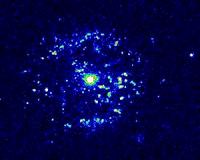 |
Montreal (AFP) Jan 4, 2011 A 10-year-old Canadian girl has become the youngest person ever to discover a supernova, or exploding star, according to the Royal Astronomical Society of Canada. Eagle-eyed Kathryn Aurora Gray, from Fredericton in the eastern province of New Brunswick, made the rare find on Sunday as she combed dozens of telescopic images of star fields in far-away galaxies. "The RASC is pleased to announce the discovery of a supernova by a 10-year-old amateur astronomer -- the youngest person ever to have made such a discovery," the society said in a statement. On spotting Supernova 2010lt in the constellation of Camelopardalis in a galaxy 240 light-years from Earth, Gray immediately told her delighted amateur astronomer father Paul. The find was then verified by two US-based amateur astronomers before being reported to the International Astronomical Union's Central Bureau for Astronomical Telegrams. Supernovae are massive stars that run out of fuel, collapse under the weight of their own gravity and become an ultra-dense object known as a neutron star. They then send out a shockwave that rips the star apart and leaves a sizzling cauldron of radiation. These colossal events are among the most thrilling phenomena for astronomers and are detected when the high-energy explosion creates a dramatic flare that eventually fades.
Share This Article With Planet Earth
Related Links Stellar Chemistry, The Universe And All Within It
 University Of Toronto Physicists Create Supernova In A Jar
University Of Toronto Physicists Create Supernova In A JarToronto, Canada (SPX) Dec 06, 2010 A team of physicists from the University of Toronto and Rutgers University have mimicked the explosion of a supernova in miniature. A supernova is an exploding star. In a certain type of supernova, the detonation starts with a flame ball buried deep inside a white dwarf. The flame ball is much lighter than its surroundings, so it rises rapidly making a plume topped with an accelerating smo ... read more |
|
| The content herein, unless otherwise known to be public domain, are Copyright 1995-2010 - SpaceDaily. AFP and UPI Wire Stories are copyright Agence France-Presse and United Press International. ESA Portal Reports are copyright European Space Agency. All NASA sourced material is public domain. Additional copyrights may apply in whole or part to other bona fide parties. Advertising does not imply endorsement,agreement or approval of any opinions, statements or information provided by SpaceDaily on any Web page published or hosted by SpaceDaily. Privacy Statement |